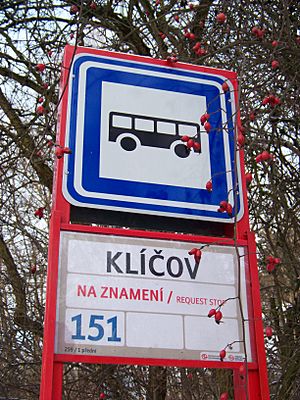Request stop facts for kids

A request stop is a special kind of stop for public transport like buses or trains. Unlike regular stops where vehicles always stop, a request stop means the vehicle only stops if someone needs to get on or off. It's like a "stop on demand" service! These stops are also sometimes called flag stops or whistle stops.
Contents
What is a Request Stop?
Imagine you are waiting for a bus or train, but it's a quiet area. At a request stop, the bus or train will only pull over if a passenger wants to get off, or if someone waiting at the stop signals that they want to get on. This helps save time and fuel because the vehicle doesn't have to stop unnecessarily.
How Do They Work?
The way a request stop works depends on the type of transport:
- For buses: If you are on the bus and want to get off at a request stop, you usually press a "stop" button inside the bus, just like at any other stop. If you are waiting at the stop, you might need to wave your hand or stand clearly visible to the driver as the bus approaches.
- For trains: On a train, you might need to tell the conductor or a staff member that you want to get off at the next request stop. If you are waiting at a train request stop, there might be a special button to press that lights up a signal for the train driver, or you might need to wave a flag or signal clearly.
Where Are They Used?
Request stops are most often found in places where there aren't many passengers. This includes:
- Rural areas: In the countryside, towns and villages can be far apart, and not many people might use a specific stop.
- Less busy routes: Even in cities, some bus or train lines might have parts that are not very popular, so request stops are used there.
- Late at night or early morning: During times when fewer people are traveling, some regular stops might become request stops to make the service more efficient.
Bus Request Stops
Many bus lines, especially in smaller towns or on the edges of big cities, use request stops. This helps the bus keep moving smoothly when there's no one to pick up or drop off. It makes the journey faster for everyone on board.
Train Request Stops
Train request stops are common on scenic or less-traveled railway lines. For example, in some mountainous or remote areas, trains might only stop at small stations if hikers or local residents need to get on or off. This allows the train to maintain its speed for most of the journey.
Images for kids
-
Traditional sign of a request stop of the former Czechoslovak national bus operator ČSAD (the sign translates to "bus stop on request".)
-
The Sjisjka stop on the Inland Line in Lapland with the traditional round, yellow sign that is to be turned towards the arriving train
See also
 In Spanish: Parada a solicitud para niños
In Spanish: Parada a solicitud para niños





